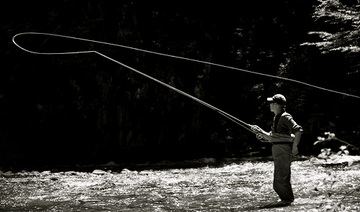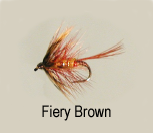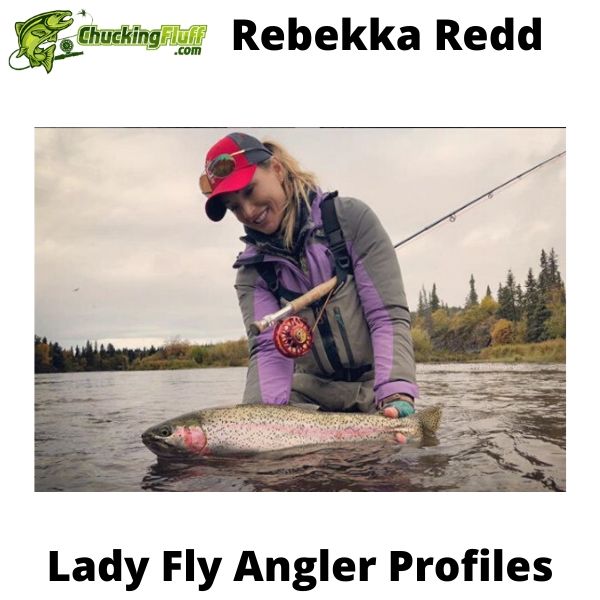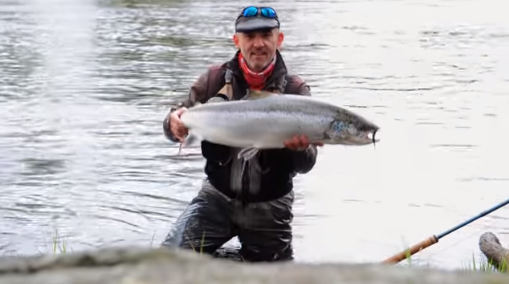| Disclosure: Just to be open and honest the buttons and links you click on in the website will in most cases take you to another website where you can purchase the products I am reviewing. As an Amazon Associate I earn from qualifying purchases. |
How to Fly Fish – Tips for the beginner.
Have you ever thought about learning how to fly fish?
It may be you have watched a fly fishing angler casting a trout rod across a river or lake and wondered could you do that.
Well I can tell you that fly fishing is no harder to perform than lure fishing when you correctly buy well balanced equipment and take a few lessons.
You could get to grips with it without the lessons but if you are a complete novice I would advise you get some lessons as it will save you time and effort in the long run.
Quick Post Navigation
To begin with what is Fly Fishing?
Fly fishing is the sport where someone uses a fly rod to cast a fly line with flies across a river or lake and retrieves them in a number of manners to try and entice the target fish into taking.
Flies are hooks tied up with feathers and materials to either look like natural insects or colored in such a way to make an aggressive reaction from the fish.
These flies are tied to the fly line with a leader material usually mono-filament or fluorocarbon and are cast using the rod and line.
The basic fly cast is called the overhead cast and consists of the fly line being pulled through the air in front and behind the caster.
The line is kept in the air in that it doesn’t touch the water or bank during the cast.
The rod is loaded by the line to put energy into the cast so it can be accelerated and cast great distances in front on the fly fishing angler.
With a bit of practice casts of 30 yards and more can be reached and are usually enough to target most species of sport and game fish.
When optimum cast length is achieved the fly is allowed to land on the water and then retrieved in different manners to try and entice the trout or fish to grab the fly.
At this point, the hook is set and the fight begins.
There are a vast array of permutations for fly fishing including rod length, fly line density, fly line weight, casting technique, leader length and pattern of flies to name the most common.

A little History on Fly Fishing
Fly fishing can be traced back to 200 AD Macedonia although at that point in history the rod and line were attached and the lure was lifted and cast into the water by simply moving it with the rod, similar to the Tenkara fishing technique of today.
The fly was made with materials very crudely tied to a hook but it worked and so fly fishing was born.
It wasn’t really until the 1620 that fly fishing was starting to be mentioned in different places up to that point it was very sketchy I suppose from the lack of books to begin with.
Later in the 18th century things start to be more familiar and fly fishing tackle dealers were more common.
The improvements in rods and reels were apparent and anglers could now buy flies from these dealers rather than making their own.
The Victorians were very active fishermen and eager to make improvements to the tackle being produced.
Hardy was opened in 1872 and the Hardy Perfect was released in 1891 after years of bringing in products from other suppliers.
The Perfect was the beginning of a tackle dealing empire that still remains at the front of the fly fishing tackle trade today.
Many changes have occurred along the way as new technology has produced new rods and reels for fly fishermen to try new tactics with.
From the split cane rods and silk lines came carbon fibers and polymer lines with light graphite reels.
Today’s angler can fish for hours with light fly fishing gear that is stronger and more flexible than its predecessors.
What is required to be able to fly fish?
Here is a list of items that one needs to be able to fly fish;
- Fly rod
- Fly reel
- Fly line
- Backing line
- Leader material
- Flies
These items will get you fly fishing but as mentioned we can add to this list with a lot of variations for instance fly lines come in floating, intermediate and sink with different sinking rates.
They come as forward taper, dual taper and shooting heads as well as in a whole selection of colors.
However, before we confuse you let’s just stick to the minimum required. A great way for the beginner to get into fly fishing is to select a fly fishing combo set.
The Single handed Fly Fishing rod!
Fly fishing rods for trout are usually single-handed and can be 2 pieces up to several pieces.
Depending on where you intend fishing will decide how many sections the rod will have.
As more pieces mean you can break it down into a small tube for traveling by airplane for instance as many fishing anglers do.
However many sections do come at a slight cost as the rod will be more expensive but also the joins do affect the action of the rod.
However, with today’s modern manufacturing techniques this effect on the action has been minimized somewhat that a novice angler may not even notice the difference.
I would advise however if not intending to fly a 2 or 3 piece rod be your target. See my article here for more info.
What are the differences in Fly Fishing Reels?
Fly fishing reels are now very light and strong being made from alloys and graphite combinations.
The lighter the reel the more expensive and it is important to find the right balance for budget and weight as a light reel will help you fish for longer without becoming tired.
There are many options for example spare spools or cartridge setups.
The reel at the end of the day is a container for the fly line and only really comes into its own when playing a fish of considerable size.
With larger fish a reel that has a drag system for setting the strength of drag off the reel will help tire the fish during the fight.
When playing small trout this is less important but playing any species it is always better to have the fly line on the reel and not lying on the ground where it can become tangled and can lose you fish.
Check out this page for more information on reels.
What is Fly Fishing Line?
As mentioned earlier fly lines come in all shapes and sizes. Basically speaking you want to match the line to the size of the rod and type of fishing.
Typically a trout set up will be a 10 ft rod rated for a 7 line. So here we now have are size being the No 7.
From here we need to know the style of fishing we require as we have different lines to cover different depths of water, different flow rates and casting techniques.
For example if fishing for trout from a banking then I would opt for the weight forward line which will give you a decent cast out to the target fish.
From here you can choose different sink rates that allow the flies to be sunk down the water column to reach fish that maybe either near the top of on the bottom.
For more information of fly lines check out this page….
Do I need Fly Fishing Backing Line?
Backing line is basically a line to help bulk up the reel so the fly line is sitting near the top of the spool and to give extra length when trout decide to run further than the 30 yards or so of fly line.
Again this is more important when fishing larger species but a decent small trout with a fast water flow can take you downstream just as quickly as a large one.
Backing comes in different strengths and diameters and again the target species will determine which you should choose.
When fishing for larger species it is a good idea to put at least 200 yards of backing on the reel where as a trout would only need about 30 yards or so.
I would always try to fill the spool to the rim and so maximize the capacity in case you do get that fish of a lifetime and it decides to run downstream.
Joining you backing to the fly line is a process that needs to be mastered so there is not a weak connection and you can find how to do this here…
Fly Fishing Leader
The fly fishing leader is what connects your fly line to your fly.
As fly line is generally thick and comes in all sorts of colours it is not generally a good idea to tie you fly directly to the fly fishing line as this will cause splash on the cast and spook fish.
It has been proved that when salmon fishing a fly can be attached directly to the fly line but as salmon which are running are not leader shy then this doesn’t affect them.
However even salmon fishing a leader material is normally used.
Trout are as a rule more leader shy and so a finer material is used to attach the fly to enhance gentle landing and make the fly look and behave more natural to them.
Further reading on how to make up a leader can be read here.
Fly Fishing Trout Flies
Fishing flies can be categorized into two main areas light and dark.
Within these you have many types from nymphs, buzzers, daddies, sedges, micros, bumbles, damsels, lures, gold heads and many others which can both be dry flies and wet flies.
A dry fly is one that is fished on the surface of the water so trout come up from below to take them on the surface and can be a very exciting way to fish as it is visual.
Wet flies are sunk into the water column and retrieved at different speeds back to the angler to entice a take from a cruising trout.
These takes can be fast and hard or soft and gentle depending on water conditions.
A flat calm would generally have trout coming in very slowly and gently where a windy day with water turbulence would generally be more dramatic as the trout feels more secure taking the fly with the camouflage of the water surface.
When fishing for brown trout some of my favorite flies are the “Butcher” the “Black Pennell” the “Fiery Brown Bumble”  the “Gold Ribbed Hare’s Ear
the “Gold Ribbed Hare’s Ear” the “Greenwell’s Glory
” the “Tups Indispensable” and “Coch-y-Bonddu”.
I would usually carry these with me whenever I go Brown trout fishing and I have had success with Sea trout and Rainbow trout on these patterns as well.
So there is the basics of equipment needed to go fly fishing,
I hope you got some information of value please feel free to share with your fishing buddies or leave comments below.



Lots of good techniques here, Mark, but I’ve yet to read any tutorials about how to acquire patience. That’s my problem. I get bored, restless, and impatient with fish that don’t realize they’re supposed to be clamping down on my hook! Have you written any fishing articles that teach or improve the art of patience? I could sure use some pointers. 🙂
Bill your doing it wrong, fly fishing correctly you will have trout taking your flies and giving you endless days of fun. If they are not taking your doing something incorrect and you need to amend. There will of course be days when nothing works, but its few and far between now I blank a day trout fishing. 🙂
Something I would like to do once I get my life balanced out. It would be great therapy and healthy eating too! It would be your articles I would consult in thls! I have caught trout when i was very young, but don’t remember how I set the bait.
I love to get out into the open air with the stillness of a river bank and cast my fly rod. Sometimes I just sit and watch the wildlife and the fish move about the pools and it is times like these that I get my best inspiration for other things in my life.
I never knew there was so much to fly fishing. I’ve always wanted to try it though.
There is more to fishing than catching fish and that goes for fly fishing also. It’s like any other sport the more you put in the more you get back. I have several rods and reels with different weighted lines etc to cover most situations I come across. I would suggest you give it ago you don’t know what you are missing. Once a trout grabs hold of your fly and takes off for the far side of the river your heart will race and you will have a smile from ear to ear. Its like adrenaline junkies once you get “hooked”, “pardon the pun”, you will not look back. I also find it great just to be outdoors taking in the scenery and watching the wildlife, at times I just sit there in silence just adsorbing it. Thanks for stopping by.
Very thorough article, Mark. Once I get all my gear, how do I know what order to assemble it? I learn best with videos, are there any that I could watch that would be helpful?
Hi Sonya did you see my post on setting up your fly line? Here Hywel’s video shows you how to join the backing to the fly line and add a braided loop. The rest of the post gives you the other details. Any problems give me a shout I’m only too happy to help.
Great site Mark,
When I lived in the UK I would go fly fishing almost every Sunday morning with my dad, stocked ponds but still great fun. If I remember correctly the fly’s I caught the most trout with were called Zonkers, they had like a long black tail.
Hi Craig yea stocked trout love Zonkers and they come in all colours not only black. The strip is usually rabbit fur dyed different colours with the lure (not really a fly) having eyes so the Zonker looks like a small fry (or fish) swimming in the lake.
Get the fly rod out again Craig you know you want to!
Hey Mark, nice post, I have done a lot of fishing myself over the years but like Tim I have never used a fly rod before. It always looked interesting to me but it seems so difficult to learn, of course you explaining what everything is and why you do it as well as where to find the fish which by the way I would like to know more about, has been really enlightening for me.
I have no idea if there is any fly fishing in the Philippines where i am currently living but if their is I intend to give it a shot, if not I will have to wait to get back to the states to try it.
Do you have any more info on how different fish swim in the river I would like to study up on some of that so that when I do go out i will have a good idea where to find the different types of fish.
Hey Ty, you are in a country that has an abundance of natural fish especially in the sea. You can fish off the beach with a fly rod and as the water is warm you don’t even need waders.
I have done some checking online and there doesn’t seem to be much in the way of stocked lakes so you will need to fish for the natural species. There are black bass in lake Calirya and lake Lumot near Manila. In fresh water there are Tilapia, and milk fish (called Bangus locally) available over most of the country. There are a few places with Baramundi (apahap), and Carp. Most if not all of these should be tempted by a fly. You could always open up your own stocked lake and introduce brown trout to the island. As there are a lot of Westerners in the Philippines there could be an opening.
As for where fish swim it all depends on the fish in question as each species has its own set of rules, however in fast flowing rivers fish will usually sit and wait for their food to come to them down the river and they will do this in the most efficient way possible. This may mean sitting behind a rock for shelter or under a fast flow in a deep pool. Rivers will always have natural eddy’s (slower flowing water) where fish can hang out resting and waiting, these are good places to try.
Each river will have its own natural and man made obstacles and it is these that you need to investigate for lying (resting) fish. Another good place to look is below a stream where it enters a bigger river as food will flow down the stream out into the river and the fish knowing this will be waiting close by.
Good luck on your quest! Let me know how you get on.
Thanks for explaining this in such an understandable manner. I’m researching this because my nephew wants to start fly fishing and I had no clue about it all. good to know.
Thanks Lisa Marie, glad it made sense to you! I have tried to write it for newbies so they can get started in the sport of fly fishing. Check out the posts on “the trout rod” and “the reel” as well as the “fly line” for more information on what to look out for. I have also written a post on how to set up the line which I found when working in the tackle shop was the main point of concern for most new anglers. Getting the knots correct can make or break a good days fishing. Any more question feel free to drop me a line and I will do what I can to help you out.
I have been fishing for years (40, or more) have never picked up a fly rod as of yet…..You are making it tempting….good work Mark…..I have even seen pike being taken on fly rod….now that looked interesting….emmmmmm
Thanks for the comment Tim, 40 years and never tried the fly you don’t know what you are missing. As for pike on the fly, great sport they really are aggressive takers. You need an 8 or 9 weight rod for pike especially if they are 12lb plus in size. Jack pike are OK on a 7 weight. Here in the British isles we release our pike so we want to bring them to the net quickly so not to exhaust them hence the need for the 8 or 9 weight rod.
Thanks Mark, this is really helpful information, especially now that I live on a river. I have been given a couple of “hands on” lessons by a friend, but only for small trout. I am just wondering if you look for the same kind of eddy pools for salmon as you would for trout in a fast river.
Hey Jim, Salmon are similar to trout and will usually sit just off the main flow where they can get good oxygenated water without having to expel a lot of energy staying there. Salmon will move up a river on at a rate dependant on the flow. If there has been a spate and the river is in good flow they will be in a hurry to get to the spawning reds. At times like this it is good to be in the tail of a pool just above a stretch of fast water. You will find the salmon take a rest after swimming the fast flow and it is then that they are prone to take a fly.
If the river is in normal flow then you need to find out their lies. These are places that have been used season after season as the natural flow of the river will give way to calmer eddies or strips where they can rest. A big boulder in the middle of the river is a good bet as is the deep pool below a fast flow. The water craft required to fully understand this takes a while to learn and you would do good to take a local to the river to show you the main lies as these will be known to seasoned anglers. New ones appear every season as the water flow is changed with erosion etc. but there will always be a few that never change. Good luck on your quest, stop by again and let me know how your getting on.
Always wondered how to fish. Thank You!
Thanks for reading Hannah I hope you learned something from it.